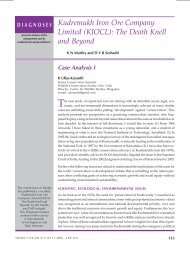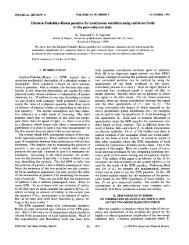Phase Transfer Catalysis - Publications of the IAS Fellows
Phase Transfer Catalysis - Publications of the IAS Fellows
Phase Transfer Catalysis - Publications of the IAS Fellows
Create successful ePaper yourself
Turn your PDF publications into a flip-book with our unique Google optimized e-Paper software.
Figure 15 shows a typical plot <strong>of</strong> intraparticle effectiveness<br />
factor vs. nondimensionless time for different values <strong>of</strong> <strong>the</strong><br />
Thiele modulus. It should be noted that <strong>the</strong> reversibility <strong>of</strong><br />
<strong>the</strong> aqueous phase ion-exchange reaction led to lower effectiveness<br />
factors than <strong>the</strong> simulations by Wang and Yang<br />
(199lb) for irreversible reactions.<br />
Activity and Selectivity <strong>of</strong> Suppotied PT Catalysts. In general,<br />
supported catalysts are known to be less active than <strong>the</strong>ir<br />
soluble analogs due to diffusional limitations. However, in <strong>the</strong><br />
case <strong>of</strong> triphase catalysis, due to <strong>the</strong> complex interactions between<br />
<strong>the</strong> solid phase and <strong>the</strong> two liquid phases, it is sometimes<br />
possible that <strong>the</strong> supported catalyst shows higher reactivity<br />
than its soluble counterpart. For example, immobilized<br />
PEG showed lower activity than <strong>the</strong> soluble analogs at equivalent<br />
concentrations, except for mono- and diethylene glycol<br />
derivatives which showed greater activity in <strong>the</strong>ir immobilized<br />
form (Kimura and Regen, 1983a). Similarly, McKenzie and<br />
Sherrington (1981) found that supported PEG catalysts gave<br />
equal or nearly equal activity as <strong>the</strong>ir soluble analogs in <strong>the</strong><br />
reaction <strong>of</strong> alkyl bromides with potassium phenoxide. Hradil<br />
and Svec (1984) observed that PEG immobilized on a macroporous<br />
glycidyl methacrylate was more active than its soluble<br />
analogs in <strong>the</strong> reaction <strong>of</strong> n-butyl bromide with sodium phenoxide.<br />
Similarly, higher reactivity and selectivity are sometimes<br />
obtained due to interactions <strong>of</strong> <strong>the</strong> support with <strong>the</strong><br />
reagents in <strong>the</strong> case <strong>of</strong> inorganic reagents like alumina or<br />
silica gel.<br />
However, it should be noted that it is <strong>of</strong>ten possible that a<br />
hydrophilic catalyst like tetramethyl ammonium chloride or a<br />
quat like TBm that partitions into <strong>the</strong> aqueous phase to a<br />
significant extent performs better in <strong>the</strong> lipophilic microenvironment<br />
<strong>of</strong> a polymer support. The lipophilicity <strong>of</strong> <strong>the</strong> polymeric<br />
support overcomes <strong>the</strong> hydrophilic nature <strong>of</strong> <strong>the</strong> onium<br />
l<br />
4 4 8 10<br />
2<br />
Figure 15. lntraparticle effectiveness factor vs. dimensionless<br />
time for different Thiele modulus<br />
values.<br />
Solid lines represent irreversible reaction UC + ~1 while<br />
dotted lines represent K = 0.1 (adapted from Desikan and<br />
Doraiswamy, 19951.<br />
d<br />
salt and increases <strong>the</strong> reaction rate. The higher reactivity observed<br />
with supported catalysts is thus explained by <strong>the</strong> fact<br />
that <strong>the</strong> localized catalyst concentration available for reaction<br />
in a triphase system can be higher than <strong>the</strong> quat concentration<br />
available for reaction in <strong>the</strong> organic phase with soluble<br />
PTC. Hence, this uncommon result <strong>of</strong> a higher reactivity<br />
using triphase catalysis as compared to soluble PTC must be<br />
viewed in <strong>the</strong> right perspective, since triphase catalysis is still<br />
plaqued by <strong>the</strong> usual diffusional limitations, and <strong>the</strong> rates observed<br />
are high only in relation to those obtained with a soluble<br />
PT catalyst that has partitioned more into <strong>the</strong> aqueous<br />
phase. The absolute values <strong>of</strong> local catalyst concentrations in<br />
<strong>the</strong> organic phases are different in <strong>the</strong> two cases and such a<br />
comparison is misleading, if not wrong. It is interesting to<br />
note from such examples that <strong>the</strong> best catalyst chosen for<br />
soluble PTC might not necessarily be a good catalyst for TPC,<br />
and vice-versa, since <strong>the</strong> polymer microenvironment can<br />
change <strong>the</strong> reactivities <strong>of</strong> <strong>the</strong> PTC catalyst. Fur<strong>the</strong>r studies<br />
on <strong>the</strong>se aspects <strong>of</strong> TPC are in progress in <strong>the</strong> senior author’s<br />
(LKD’s) laboratory, and some interesting results are expected<br />
to be published soon.<br />
An interesting effect <strong>of</strong> <strong>the</strong> support microenvironment on<br />
<strong>the</strong> selectivity <strong>of</strong> reaction has been reported in <strong>the</strong> alkylation<br />
<strong>of</strong> p-napthoxide with benzyl bromide (Ohtani et al., 1981).<br />
Selectivity could be manipulated merely by changing <strong>the</strong> degree<br />
<strong>of</strong> ring substitution (% RS) <strong>of</strong> <strong>the</strong> 1% DVB cross-linked<br />
polystyrene support. With a catalyst with 17% RS, O-alkylation<br />
was predominant (94%) while a catalyst with 52% RS<br />
gave 81% <strong>of</strong> <strong>the</strong> C-alkylation product. Differences in <strong>the</strong> microenvironment<br />
<strong>of</strong> <strong>the</strong> catalyst support were suggested as a<br />
possible explanation for this interesting observation. It is<br />
known that <strong>the</strong> dipolar aprotic environment favors O-alkylation<br />
in this reaction, while water favors C-alkylation. The latter<br />
catalyst was highly solvated by water and little by <strong>the</strong> organic<br />
solvent (toluene) used, while <strong>the</strong> former catalyst was<br />
moderately swollen by toluene and poorly by water. The authors<br />
postulate a mechanism similar to that <strong>of</strong> inverted micellar<br />
action for <strong>the</strong> reaction.<br />
Capsule Membrane PTC. In a modification <strong>of</strong> triphase<br />
catalysis, hydrophobic onium salts or poly(ethylene oxide)<br />
were grafted onto <strong>the</strong> surface <strong>of</strong> a porous ultrathin nylon<br />
capsule membrane (Okahata and Ariga, 1986). Typical dimensions<br />
<strong>of</strong> <strong>the</strong> capsule membrane were 25 mm diameter and<br />
a thickness <strong>of</strong> 5 microns. The organic solvent with <strong>the</strong> organic<br />
substrate was trapped within this capsule with <strong>the</strong> nucleophilic<br />
reagent present in <strong>the</strong> outer aqueous phase. After reaction,<br />
<strong>the</strong> capsule was broken and <strong>the</strong> product recovered<br />
easily. The catalyst remained on <strong>the</strong> surface <strong>of</strong> <strong>the</strong> polymeric<br />
membrane. No induction time was required, as is needed<br />
while using polymer supports. Comparison <strong>of</strong> reactivities <strong>of</strong><br />
<strong>the</strong> capsule membrane system to that observed by using solu-<br />
ble PTC in a stirred reactor showed that <strong>the</strong> capsule membrane<br />
showed <strong>the</strong> higher reactivity (Okahata and Ariga, 1986),<br />
possibly due to free movement <strong>of</strong> <strong>the</strong> onium salts attached to<br />
long graft polymer chains at <strong>the</strong> interface <strong>of</strong> <strong>the</strong> ultrathin<br />
(low diffusional limitations) membrane capsule. It is speculated<br />
that <strong>the</strong>se spacer chains can even -form a micellar like<br />
structure at <strong>the</strong> organic/water interface. However, kinetic<br />
analysis and experimental results were consistent with a PTC<br />
mechanism which apparently ruled out <strong>the</strong> possibility <strong>of</strong> a<br />
micellar or emulsion-like environment at <strong>the</strong> interface.<br />
AIChE Journal March 1998 Vol. 44, No. 3 633
















